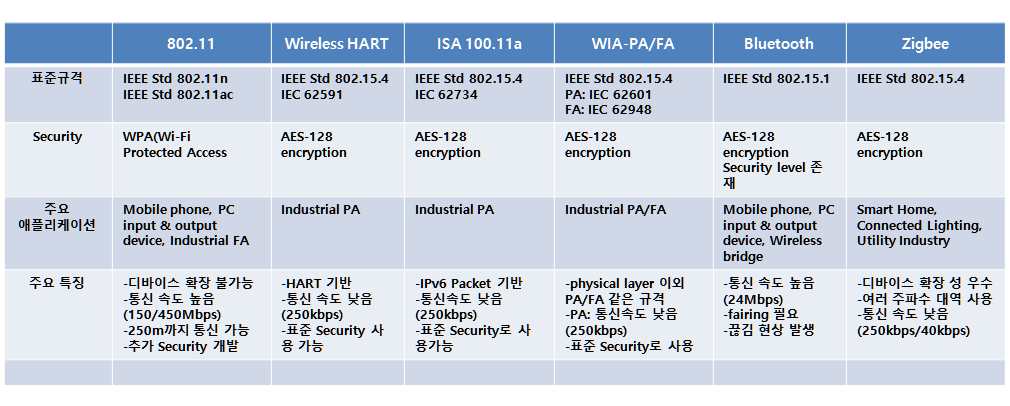제조업 혁신에 따른 스마트 공장이 이슈화되면서 산업용 네트워크 기술에도 관심이 높아지고 있다.
산업 네트워크 기술이 유선 통신에서는 현재 산업용 이더넷이 급속도로 확대되고 있으며, 무선 통신 분야는 802.11 기술을 기반으로 제어용보다는 모니터링 목적으로 주로 활용되고 있는 것으로 나타났다.
우선 산업용 유선 통신은 기존 필드버스(Fieldbus)의 강점과 일반 이더넷(Ethernet)의 강점을 고려한 산업용 이더넷 기술이 확산되고 있다. 필드버스는 배선의 편의성과 소량 데이터 처리 능력이 탁월하며 무엇보다 가격 경쟁력에 검증된 기술이라는 점에서 많이 사용되고 있는 산업용 통신 기술이다. 하지만 통신 미디어 및 호환성이 부족하고 증가하는 응용 요구에 대응하지 못하며 무엇보다 속도에 제약(12~16Mbps)이 있고 이중화(Redundancy) 기능 구현이 취약하다는 단점이 있었다.
기존 필드버스와 일반 이더넷 장단점 보완, 속도 및 이중화 강점
무선 통신은 802.11 기술 기반으로 모니터링 목적으로 도입 늘어
제조업 혁신에 따른 스마트 공장이 이슈화되면서 산업용 네트워크 기술에도 관심이 높아지고 있다.
산업 네트워크 기술이 유선 통신에서는 현재 산업용 이더넷이 급속도로 확대되고 있으며, 무선 통신 분야는 802.11 기술을 기반으로 제어용보다는 모니터링 목적으로 주로 활용되고 있는 것으로 나타났다.
우선 산업용 유선 통신은 기존 필드버스(Fieldbus)의 강점과 일반 이더넷(Ethernet)의 강점을 고려한 산업용 이더넷 기술이 확산되고 있다. 필드버스는 배선의 편의성과 소량 데이터 처리 능력이 탁월하며 무엇보다 가격 경쟁력에 검증된 기술이라는 점에서 많이 사용되고 있는 산업용 통신 기술이다. 하지만 통신 미디어 및 호환성이 부족하고 증가하는 응용 요구에 대응하지 못하며 무엇보다 속도에 제약(12~16Mbps)이 있고 이중화(Redundancy) 기능 구현이 취약하다는 단점이 있었다.
 ▲Siemens 산업용 이더넷 스위치
▲Siemens 산업용 이더넷 스위치
이에 반해 이더넷은 고속의 전송 속도(10M~10Gbps)에 통신 미디어 호환성이 있고 일반인에게 친숙한 주류 기술이라는 강점이 있으나 토폴로지가 취약하고 비 결정론적, 외장 스위치 및 허브가 필요하다는 단점이 있다.
LS 산전의 권대현 책임 연구원은 “그 동안 산업용 네트워크에서는 소량 데이터만을 처리하면 되었기에 필드버스가 오랫동안 사용되어 왔지만 이제는 공장에도 동영상 데이터가 늘어나면서 전송 속도가 빨라져야 한다”며, “또한 일반 이더넷도 문제가 있다. 가격경쟁력을 갖췄지만 스위치 하나가 고장나면 전체 시스템에 문제가 생기기도 했다”고 말했다.
산업용 이더넷 시장, 연간 20% 지속 성장
이에 이들 유선 통신 표준의 장점을 가진 산업용 이더넷이 대세다. 산업용 이더넷은 고속의 전송 속도에 통신 미디어 호환성은 물론 리니어/링/메시 구조 토폴로지로 토폴로지 취약성을 보완했다. 특히, 강력한 리던던시 기능에 1ms 레벨의 실시간 통신, 1us 레벨의 시간 동기화 기능으로 단점을 보완했다.
산업용 이더넷 시장은 연간 20% 수준으로 지속 성장하고 있으며 기존 네트워크들을 이더넷으로 통합하고 있다. 이를 수치상으로 나타내면 2013년 약 4조원 규모의 시장이 2016년에는 7조원 시장을 형성할 것으로 보이며 2018년에는 10조원이 넘을 것으로 예상된다. 기술 면에서는 이더넷의 실시간성 증대와 케이블 및 커넥터 공용화로 기존의 3 레벨 네트워크를 1개로 통합화를 주도하고 있다. 더구나 수 천 만개의 디바이스까지 적용 가능해 향후 영향력이 극대화할 것이라는 전망이다.
 ▲산업용 무선 통신 규격 비교
▲산업용 무선 통신 규격 비교
이에 따라 기존 시리얼 통신 기반에서 산업용 이더넷 기반으로 확산하고 있다. 개발이 편리하고 호환성을 고려한 기본 이더넷 기술에서 성능, 이중화(Redundancy), 안전(Safty)을 고려한 기술도 이동하고 있다. 이에 반해 빠르게 성장하던 EtherCAT 기술은 모션 분야에 한정되어 비중이 소폭 감소하고 있는 것으로 나타났다.
Profinet 기술을 활용한 지멘스가 영역을 확장하고 있는 것도 주목할만하며 아시아에서는 미쓰비시의 CC-Link가 강세인 것이 특징이다. 이들 업체들은 산업용 제어 네트워크를 하위 디바이스 통신으로 확대 전개하고 있다. 지멘스는 Profinet으로 통해 계측을 전반적으로 확장하고 있으며 미쓰비시는 컨트롤 및 디바이스 계측을 이더넷 기반인 CC-Link IE로 일원화 네트워크를 추진하고 있는 것이 그 예이다. 국내 LS산전은 다양한 통신 모듈을 확보하여 RAPIEnet 확산 전략을 확대하고 있다. 미국기업 Rockwell은 상위계층은 EtherNet/IP, 하위는 DeviceNet으로 표준화하고 디바이스 영역도 이더넷 솔루션을 확대하였다.
산업용 무선 통신은 Wi-Fi 기술과 802.15.4 기반 기술 중심으로
산업용 무선 통신의 괄목할 만한 성장도 눈여겨 볼만하다. 무선 통신은 시스템별로 분류할 수 있다. 크로스 플랜트(Cross Plant Wireless Network)는 원거리 유지 보수 및 제어를 위한 무선 네트워크이며, 플랜트 와이드(Plant wide)는 다양한 플랜트 애플리케이션을 위한 무선 네트워크이다. 센서/엑추에이터 무선 네트워크는 게이트웨이를 통해 필드레벨에서 동작하는 센서 엑추에이터 노드를 모니터링한다. 산업용 무선 네트워크는 에머슨, GE, 허니웰 중심으로 시장이 확대되고 있으며 개별 표준 및 WirelessHART/ISA 100.11a 위주로 개발되고 있다.
산업용 무선 통신은 6가지 활용 사례를 중심으로 필요성이 대두된다. 이는 ▲운성 기기 주변에 있는 작업자의 안전 ▲석유 탱크 집합 지역에서 레벨 모니터링과 알람 ▲모바일 무선 장비 필드 작업자 지원 ▲진동 모니터링과 회전하는 기기의 분석 ▲기름 유정 모니터링과 제어 ▲많은 노드가 있는 공장 자동화를 위한 몇몇 애플리케이션 등이다.
무선 통신 분야는 802.11을 기반으로 한 Wi-Fi 기술과 802.15.4 기반 기술이 있다. IEC에서 주파수 대역은 산업 환경을 고려하여 대역폭(80MHz), 주파수(1.4GHz~6GHz)를 검토하고 있다. 지멘스, 로크웰, 미쓰비시, 슈나이더 등의 전문 업체들의 적용 기술을 보면 WLAN과 블루투스가 상당한 비중을 차지하고 있는 것으로 나타났다. 이 무선 기술들은 제어용보다는 모니터링 목적으로 주로 활용되었다.
LS 산전의 권대현 책임은 “산업용 통신이 일반 통신과 다른 점은 실시간 통신 및 에러 발생시 결정론적인 복귀 시간을 규정한다는 것”이라며 “고가용성, 기능 안전, 보안 등도 중요 고려 사항으로 산업 분야에 적용된다”고 밝혔다.